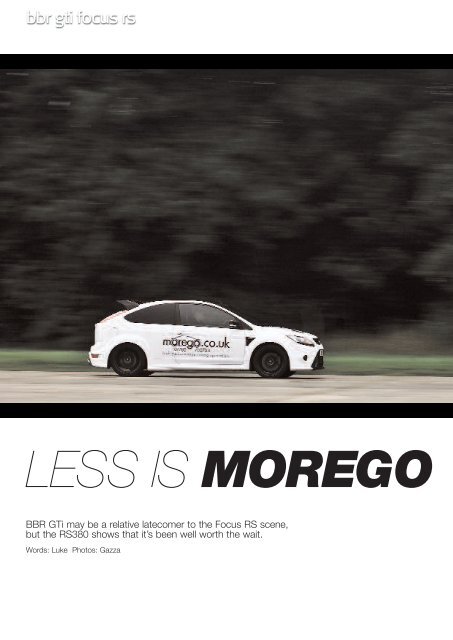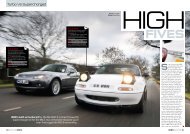LESS IS MOREGO - BBR GTi.
LESS IS MOREGO - BBR GTi.
LESS IS MOREGO - BBR GTi.
Create successful ePaper yourself
Turn your PDF publications into a flip-book with our unique Google optimized e-Paper software.
gti focus rs<br />
<strong>LESS</strong> <strong>IS</strong> <strong>MOREGO</strong><br />
<strong>BBR</strong> <strong>GTi</strong> may be a relative latecomer to the Focus RS scene,<br />
but the RS380 shows that it’s been well worth the wait.<br />
Words: Luke Photos: Gazza
PF TESTED<br />
0-10mph 0.9 secs<br />
0-20mph 1.8 secs<br />
0-30mph 3.0 secs<br />
0-40mph 3.8 secs<br />
0-50mph 4.6 secs<br />
0-60mph 5.7 secs<br />
0-70mph 7.4 secs<br />
0-80mph 8.7 secs<br />
0-90mph 10.6 secs<br />
0-100mph 12.3 secs<br />
vMax 159.5mph<br />
The race to build the fastest, most powerful Mk2 Focus RS has been on<br />
since the first models landed in the UK at the beginning of last year. And if<br />
the current rate of progress is anything to go by, it’s a race that looks set<br />
to run for a considerable amount of time yet. So far, we’ve seen power<br />
figures rise well into 400bhp territory and when you consider the potential<br />
of the 2.5-litre turbocharged RS, it’s only going to be a matter of time before this kind<br />
of output is eclipsed. When you look at what’s been done with 1.8-litre and 2.0-litre<br />
capacity turbocharged engines, some of which have been tuned to produce well over<br />
double that figure, logic dictates we’ll see the same, if not more, from the big, beefy<br />
five-pot that comes as standard with the current RS flagship.<br />
The only problem with chasing big horsepower though, is that the overall<br />
driveability of the car tends to get lost in the quest for pub bragging rights. Now,<br />
we’re not saying that everyone should stop building and engineering engines, in fact,<br />
far from it. However, if you’re intent on driving your car everyday, and are perhaps<br />
partial to the odd track day every now and again, there comes a point when you want<br />
more of a balance between speed and usability.<br />
With that in mind, it’s not surprising that most tuners are offering a range of<br />
upgrades for the current Focus RS, from a simple ECU tweak and working up to bigger<br />
and better things depending on individual budgets and requirements. Take <strong>BBR</strong> <strong>GTi</strong> for<br />
instance – a relative newcomer to the Mk2 Focus RS party, but a company that has<br />
been involved with making Fords go faster since the RS500 Touring Cars of the 1980s.
046
<strong>BBR</strong> <strong>GTi</strong>, or Brodie Britain Racing and <strong>GTi</strong> Engineering are names that are steeped in<br />
motorsport history and, as such, the company boasts a very impressive CV indeed.<br />
Along with its former touring car credentials (David Brodie held the lap record at<br />
Thruxton for many years in a Sierra RS500), <strong>BBR</strong> <strong>GTi</strong> has a wealth of experience tuning<br />
and building cars, and not just Fords either. Everything from MINIs and numerous Golf<br />
GTIs have passed through its doors, not to mention 1000bhp Astons, a 365bhp Lotus<br />
Elise built for non other than Adrian Newey, plus a factory- approved turbo kit for<br />
Mazda MX5s to name just a few.<br />
Of course, with such a strong background in racing the iconic RS500, <strong>BBR</strong> has<br />
always had a special interest with Fords, and especially the Mk2 Focus.<br />
The company began developing the ST in 2005 and, not long after, it produced a<br />
range of upgrade packages, starting with a 280 and 290 kit that consisted of an<br />
exhaust, filter swap, custom remap and its most extreme 360 package that<br />
incorporated a bigger turbo and fabricated manifold. A great RS-beater for sure, but<br />
by <strong>BBR</strong>’s own admission it is a rather expensive conversion! To fill the gap in ST<br />
conversions by modifying the standard turbo, <strong>BBR</strong> then offered a 330 kit as a more<br />
cost-effective upgrade for 300bhp plus.<br />
When the new RS started to appear, and with many ST owners wishing to trade up<br />
to the greater performance it offered as standard, <strong>BBR</strong> once again turned its attention<br />
to a range of power upgrades. After 18 months of extensive R&D, it now offers four<br />
different tuning options; from the Phase One ECU remap that boosts power to 342bhp<br />
and 369lb ft of torqe, to the Phase Four <strong>BBR</strong> RS400 which produces 404bhp and 408lb<br />
ft of torque thanks to a hybrid turbo, high flow fuel pump, high flow injectors,<br />
intercooler, air filter, full exhaust and remap.<br />
While the RS400 conversion is aimed at customers that want supercar-beating<br />
performance from their Focus, <strong>BBR</strong> is convinced that its Phase Three upgrade, which is<br />
without the expensive turbo replacement but still offers a healthy 382bhp and 388lb ft<br />
of torque, is more than enough for those who like to use their car on a regular basis.<br />
So, in the interests of science, we asked if we could borrow <strong>BBR</strong>’s RS380<br />
demonstrator to see just how well it performed against the clock and to see if it<br />
measured up to <strong>BBR</strong>’s claims that it works well on everyday roads as well.<br />
First up though, were the performance tests, and with a foggy, but otherwise<br />
deserted Bruntingthorpe Proving Ground at our disposal, we fired up our trusty<br />
Racelogic timing gear and set about chasing some 0-60mph times. Actually, we were<br />
more interested in the 0-100mph and top speed times because if there’s one thing<br />
we’ve learnt about the Mk2 Focus RS so far, it’s that there’s a limit to how quickly you<br />
can get it off the line on standard road tyres – even with the Quaife ATB diff doing its<br />
best to keep the front wheels in order.<br />
The first few runs proved promising, with consistent 5.6-5.7-second sprints to<br />
60mph and a low 12secs to 100mph, being the order of the day. We tried several<br />
methods of getting <strong>BBR</strong>’s RS off the line, including a second gear start (which<br />
amazingly only proved to be a few tenths slower!) then eventually resigned ourselves<br />
to the fact that the tyres were only going to give us so much. If we had a set of<br />
sticky track rubber we would have no doubt taken a big chunk out of the sprint times,<br />
but then at least these figures are a good representation of what the RS380 is<br />
capable of in the real world. And let’s face it, hitting the ton in just over 12 seconds<br />
from a standing start in a heavy front wheel drive car is not to be sniffed at.<br />
With the sprint times clarified, we moved our attention to the vMax tests, for<br />
which we would have to use the full length of Bruntingthorpe’s near two-mile runway.<br />
Our realistic aim here was to crack the 160mph barrier, and, after a couple of practice<br />
runs that clocked 156 and 158 we wound back the door mirrors, took a couple of brave<br />
pills and nailed the throttle for a final attempt – only to run out of runway with<br />
159.9mph registered on the timing gear! With maybe another mile or so of asphalt to<br />
047
gti focus rs<br />
play with we’re pretty confident that we could have squeezed out at least another<br />
three of four mph. Still, anything that can achieve these kind of speeds, while still<br />
being fully decked out with leather, sat nav and reversing camera is good enough for<br />
us. So, the <strong>BBR</strong>380 is clearly a quick car, and the <strong>BBR</strong>400 would no doubt be faster<br />
still, but for <strong>BBR</strong> the extra power is only part of the story.<br />
“In our opinion, one of the RS’ biggest failings is its ride quality,” explains <strong>BBR</strong>’s<br />
Neil McKay. “Our bespoke damper and spring kit transforms the ride of the car, and is<br />
more adapt at soaking up the potholes and uneven surfaces of UK A and B roads.”<br />
If this sounds like <strong>BBR</strong> is being soft, then don’t be fooled into thinking that this is<br />
just about comfort. A car with rock hard suspension might handle a bit better on the<br />
smooth surfaces of a track, but over the lumps and bumps of your favourite back road<br />
there’s a good chance it will skip and slide all over the place when you put your foot<br />
down. <strong>BBR</strong> decided straight away that the standard dampers on the RS were too hard,<br />
and after dyno testing them back-to-back with the ST suspension, claim that they<br />
were producing maximum damping very early on under compression. In short, they<br />
were too stiff. <strong>BBR</strong>’s solution was to develop its own springs matched to a set of<br />
<strong>BBR</strong>/Koni-developed adjustable dampers – a combination that offers a gentle reduction<br />
in ride height, and a much more effective overall suspension setup on the road.<br />
According to Neil, “the suspension is somewhere between the ST and RS in terms of<br />
stiffness,” so it’s still firm, but much more forgiving when the going gets rough.<br />
The exact difference between this and the standard RS setup is hard to gauge<br />
unless you were to drive both cars back-to-back, but after heading out on to the tight<br />
and twisty lanes that surround Bruntingthorpe, we can confirm that the RS380 felt<br />
100% planted on even the most undulating tarmac. Confidence-inspiring is probably<br />
the best way to describe it; being able to absolutely nail it around corners and<br />
roundabouts safe in the knowledge that the car is going to continue in the direction<br />
that you’re pointing it, rather than fidgeting around and trying to make a break for<br />
freedom. Given that the adjustable dampers allow you to stiffen things up if you<br />
fancy heading out onto a track day, we reckon that the <strong>BBR</strong> setup really does offer a<br />
best of both worlds solution for the RS.<br />
If there’s one criticism though, it’s that there might be a danger that you’d soon get<br />
used to the RS380’s performance. Don’t get us wrong, this is a fast bit of kit and one<br />
that could be enjoyed everyday, whether crawling along in the morning commute or at<br />
full chat on a sunny Sunday afternoon. The problem is that it’s all just too easy,<br />
especially with <strong>BBR</strong>’s excellent suspension setup, so if you’re anything like us then<br />
there’s a danger that you might find yourself hankering after even more power. Still, if<br />
and when that happens, we guess you just need to save a few more pennies and go<br />
back to <strong>BBR</strong> for the full fat RS400 ■<br />
Contact<br />
<strong>BBR</strong> <strong>GTi</strong><br />
www.morego.co.uk<br />
048
<strong>BBR</strong> PHASE ONE<br />
Custom remap with <strong>BBR</strong> Star Chip<br />
342bhp @ 6150rpm, 369lb ft @ 3350rpm<br />
Price: £595<br />
<strong>BBR</strong> RS355 PHASE TWO<br />
<strong>BBR</strong> intercooler, silicon hose kit, high flow air filter, Star Chip remap<br />
355bhp @ 6580rpm, 378lb ft @ 3000-4600rpm<br />
Price: £1245<br />
<strong>BBR</strong> RS380 PHASE THREE<br />
<strong>BBR</strong> intercooler, silicon hose kit, high flow air filter, <strong>BBR</strong> spec 3”<br />
exhaust with sports cat, larger injectors, Star Chip remap<br />
382bhp @ 6080rpm, 388lb ft @ 3000-4650rpm<br />
Price: £2495<br />
<strong>BBR</strong> RS400 PHASE FOUR<br />
<strong>BBR</strong> intercooler, silicon hose kit, high flow air filter, <strong>BBR</strong> spec 3”<br />
exhaust with sports cat, larger injectors, high flow fuel pump, hybrid<br />
turbo, Star Chip remap<br />
404bhp @ 6220rpm, 408lb ft @ 3380rpm<br />
Price: £3895<br />
<strong>BBR</strong> Koni adjustable dampers £795<br />
<strong>BBR</strong> lowering springs £195<br />
(prices exclude fitting)<br />
049




